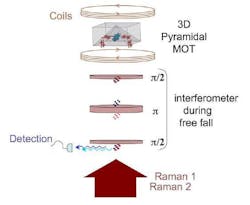Cold-atom gravimeter requires only one laser beam
Atom interferometers used as sensitive gravimeters (which detect the strength of the local gravity field, or g) are normally quite complex, requiring nine independent laser beams and associated optics, making them too cumbersome to use in the field. Researchers at LYN-SYRTE, UPMC (Paris, France) have created a cold-atom gravimeter based on Raman transitions that requires only one laser beam and is very compact. The device relies on a 3D hollow pyramidal magneto-optic trap (MOT) to trap the atoms; the four inner mirrors of the trap also produce the proper polarizations to drive the Raman transitions and measure the positions of the falling atoms.
The MOT, which is custom-made from two glass corner cubes and two glass isosceles rectangular prisms, has a 20 × 20 mm pyramid base and mirror faces that are perpendicular to each other to within one arc minute. Two laser diodes are tuned to frequencies close enough to correspond to the microwave transition of the ground levels of rubidium (Rb). The combined collimated beam enters along the axis along which the Rb atoms fall. Measurement of g is achieved by adjusting the Raman frequency difference until its chirp compensates the measured Doppler shift (which changes as the atoms fall). Measurements taken over a 50 h span matched variations expected from the earth's tides, with a short-term (1 s) sensitivity of 1.7 × 10-7 g. Contact Arnaud Landragin at [email protected].
